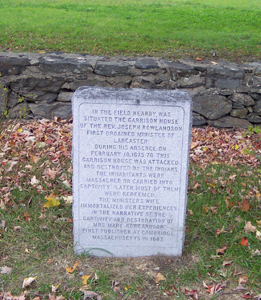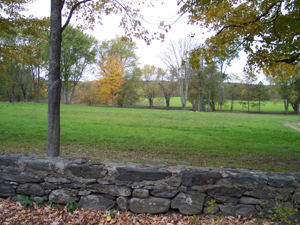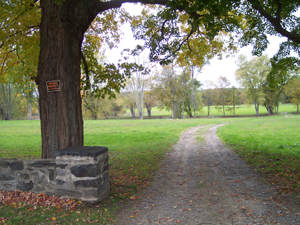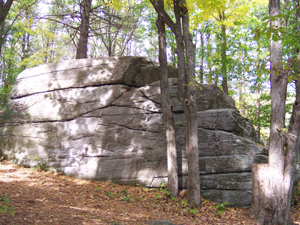From the beginning of English
 Marker in Lancaster Massachusetts
settlements in the New England colonies,
there were skirmishes, attacks, pillaging, abductions, battles, and, of course,
wars: Queen Ann's War, King William's War, the French and Indian War, and
King Philip's War. The last, which took place from 1675 to 1676, was the
bloodiest, but it has been almost completely ignored by history textbook writers.
Marker in Lancaster Massachusetts
settlements in the New England colonies,
there were skirmishes, attacks, pillaging, abductions, battles, and, of course,
wars: Queen Ann's War, King William's War, the French and Indian War, and
King Philip's War. The last, which took place from 1675 to 1676, was the
bloodiest, but it has been almost completely ignored by history textbook writers.
Eric Schultz and Michael Tougias have written an excellent guide to the study
of this war (King Philip's War, Countryman Press, 1999). They say (pages 4-5):
Between six hundred and eight hundred English died in battle during King Philip's
War. Measured against a European population in New England of perhaps fifty-two
thousand, this death rate was nearly twice that of the Civil War and more than
seven times that of World War II.
 Rowlandson family farmland
The English Crown sent Edmund Randolph to
assess damages shortly after the war and he reported that twelve hundred homes
were burned, eight thousand head of cattle lost, and vast stores of foodstuffs
destroyed. Thousands of survivors became wards of the state, prompting churches
in England and Ireland to send relief ships to New England's aid ... For all their suffering, the English fared well compared to New England's
Native American peoples. During the war, the English attacked and massacred
Narragansett and Wampanoag at the Great Swamp in South Kingstown, Rhode Island,
along the Connecticut River in present-day Turner's Falls, Massachusetts, and
in locations as separate as the Housatonic River in western Massachusetts and
the Pawtucket River north of Providence. Some of the most grisly executions
were of native women and children trying desperately to flee the war or surrender.
One account estimated that three thousand Native Americans were killed in battle.
In a total population of about twenty thousand, this number is staggering.
Rowlandson family farmland
The English Crown sent Edmund Randolph to
assess damages shortly after the war and he reported that twelve hundred homes
were burned, eight thousand head of cattle lost, and vast stores of foodstuffs
destroyed. Thousands of survivors became wards of the state, prompting churches
in England and Ireland to send relief ships to New England's aid ... For all their suffering, the English fared well compared to New England's
Native American peoples. During the war, the English attacked and massacred
Narragansett and Wampanoag at the Great Swamp in South Kingstown, Rhode Island,
along the Connecticut River in present-day Turner's Falls, Massachusetts, and
in locations as separate as the Housatonic River in western Massachusetts and
the Pawtucket River north of Providence. Some of the most grisly executions
were of native women and children trying desperately to flee the war or surrender.
One account estimated that three thousand Native Americans were killed in battle.
In a total population of about twenty thousand, this number is staggering.
We are discovering that several of our ancestors, unsurprisingly, were greatly
affected by the war.
JOHN HOAR
The first minister to the small village of Lancaster
 Site of Rowlandson farmhouse
in Massachusetts was
John Rowlandson, who lived on a farm with his wife Mary and their children.
Near the beginning of the hostilities, Mary and her infant were captured and
carried off by Indians. Her baby died and her two older children were separated
from her. She lived with the Indians for three months before being rescued by
John Hoar. She told her story in The Narrative of the Captivity and Restoration
of Mrs. Mary Rowlandson, which became widely popular in the months following the
end of the war.
Site of Rowlandson farmhouse
in Massachusetts was
John Rowlandson, who lived on a farm with his wife Mary and their children.
Near the beginning of the hostilities, Mary and her infant were captured and
carried off by Indians. Her baby died and her two older children were separated
from her. She lived with the Indians for three months before being rescued by
John Hoar. She told her story in The Narrative of the Captivity and Restoration
of Mrs. Mary Rowlandson, which became widely popular in the months following the
end of the war.
Her story reveals her practical character.
Even though she and the baby were wounded
(shot by the same bullet during her capture) she kept up with her captors as they
fled and made herself useful. She, like all other colonial housewives, carried her
sewing kit with her, so she was able to mend and sew garments for her captor,
thus increasing her own value.
John Hoar was entrusted with the mission of ransoming Mrs. Rowlandson. With two
Indian escorts, he arrived at the campsite. The Indians attempted to frighten him
by shooting near his horse, by shouting threats and making menacing gestures.
He had brought food for a feast dinner, as well as tobacco -- a gift for Mary
Rowlandson from her husband, which she sold to the Indians.
During the next two days, negotiations for Mary Rowlandson's release continued,
until finally, with the aid of a pint of liquor, and the encouragement of a majority
of the sachems meeting in council, the deal was made. John Hoar and Mary Rowlandson
rode out of the Indian camp.
 Redemption Rock
At sundown they came to the Rowlandson farm in Lancaster
where she found that most of the town had been burned and all the occupants had fled.
Redemption Rock
At sundown they came to the Rowlandson farm in Lancaster
where she found that most of the town had been burned and all the occupants had fled.
The following day John Hoar completed his mission, returning Mary Rowlandson to her husband
in Concord where he had been waiting.
John Hoar is Elsa's seventh-great-uncle.
The rescue of Mary Rowlandson landed John Hoar in the history books, but the rest of
his life is fascinating as well. In an excellent article (New England Ancestors,
Fall 2005, pages 53-54), Diane Rappaport follows the career of this man --
"the feisty lawyer spoke his mind no matter how powerful his adversary".
Convinced that the local Massachusetts justices were corrupt, he attempted to bring
a complaint against them. For this
he was punished. He was fined and forbidden to practice law in the colony. It is
probable that he accepted the mission to ransom Mary Rowlandson because he
needed the fee.
He was a man of great integrity throughout his life. Diane Rappaport says:
"When King Philip's War erupted in 1675, Hoar stepped forward to protect
sixty friendly Native Americans who lived near Concord. While authorities
interned other Christian Indians on a barren island in Boston harbor, Hoar invited
Concord's native neighbors to live on his own property. At great personal expense,
he built them a workshop and palisade behind his house and helped to harvest their
corn. He was unable, however, to stop soldiers who finally came to take these
Indians away after the attack on Lancaster." (ibid, page 54.)
Later, toward the end of the war, a half-dozen Indians were murdered near his home.
His son, Daniel Hoar,
 Forest near Redemption Rock
was tried and convicted of the murder, but was pardoned at
the last minute.
Forest near Redemption Rock
was tried and convicted of the murder, but was pardoned at
the last minute.
We can only imagine the effect testy, stubborn, courageous John Hoar had upon the
captors of Mary Rowlandson.
Further Reading:
Two excellent recent books on King Philip's War are:
Lepore, Jill. The Name of war: King Philip's War and the origins of American
identity. Knopf, 1999.
Schultz, Eric and Michael J. Tougias. King Philip's war: the history and legacy of
America's forgotten conflict. Countryman Press, 2003.
Earlier works include:
Rowlandson, Mary, The Narrative of the Captivity and Restoration of Mrs. Mary
Rowlandson Various editions.
Bodge, George M. Brief history of King Philip's war, 1675-1677: including supplemental
material from soldiers in King Philip's War. various editions. Originally privately
printed, 1891. Note: This book is anexample of the school of historical narrative which
glorifies the winning side, speaking of the Indians as savages and emphasizing the
bloody deeds of the soldiers. It is, however, generally considered the most complete
description of the war.
Church, Benjamin. Entertaining passages relating to Philip's war.
originally published in 1716. To hear Church tell it, he was the greatest
single hero of the war.
 Marker in Lancaster Massachusetts
settlements in the New England colonies,
there were skirmishes, attacks, pillaging, abductions, battles, and, of course,
wars: Queen Ann's War, King William's War, the French and Indian War, and
King Philip's War. The last, which took place from 1675 to 1676, was the
bloodiest, but it has been almost completely ignored by history textbook writers.
Marker in Lancaster Massachusetts
settlements in the New England colonies,
there were skirmishes, attacks, pillaging, abductions, battles, and, of course,
wars: Queen Ann's War, King William's War, the French and Indian War, and
King Philip's War. The last, which took place from 1675 to 1676, was the
bloodiest, but it has been almost completely ignored by history textbook writers.
 Rowlandson family farmland
Rowlandson family farmland Site of Rowlandson farmhouse
Site of Rowlandson farmhouse Redemption Rock
Redemption Rock Forest near Redemption Rock
Forest near Redemption Rock